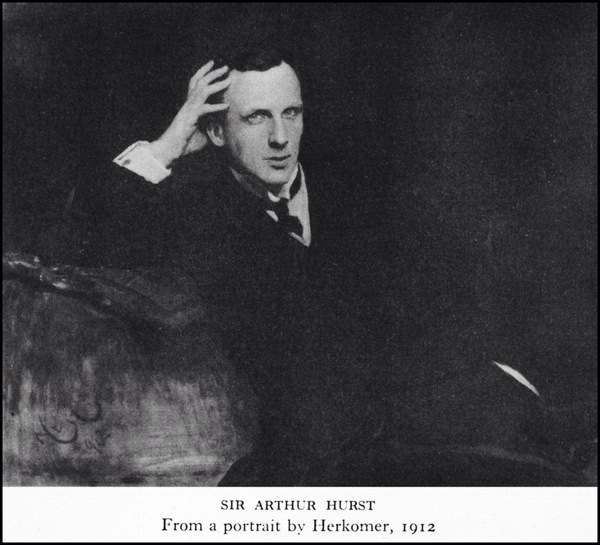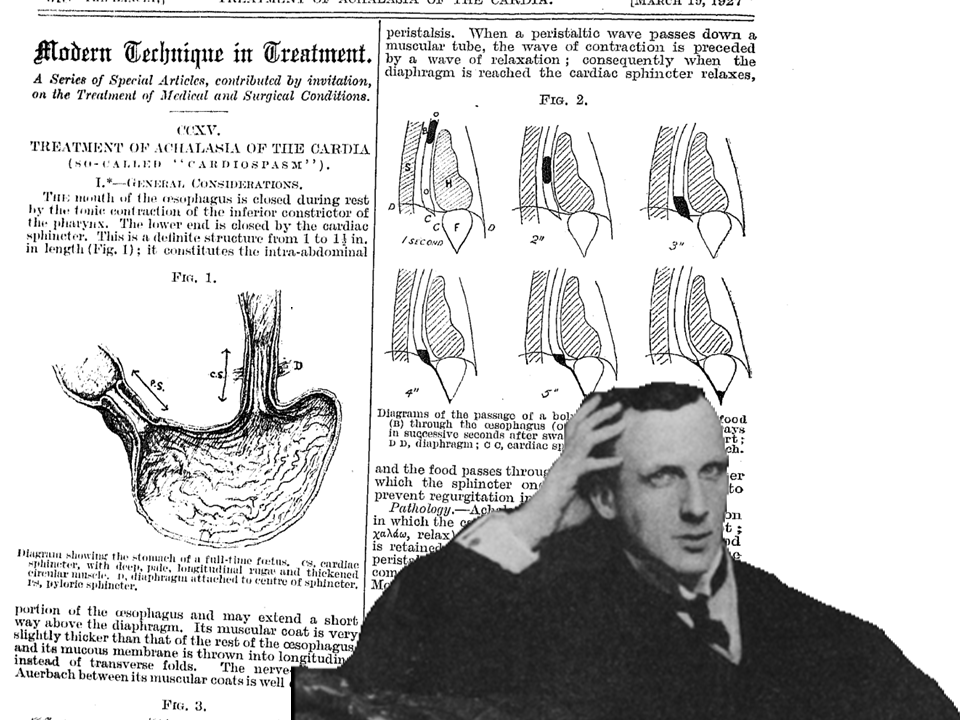Sir Arthur Hurst 1879-1944
Categories: Jewish Heritage Walks

Picture Source: http://m.jmb.sagepub.com/content/18/3/158/F1.expansion
Sir Arthur Hurst was born at 3 Oak Mount, Manningham, where he lived until 1894 when his family moved to Manchester. The family name was Hertz until 1916 when it was changed to Hurst because of the war Germany and the ensuing anti-German feeling. The family was of German-Jewish origin and had moved to England in the first half of the nineteenth century.
Sir Arthur Frederick (1879–1944), physician, was born at 3 Oak Mount, Manningham, Bradford, on 23 July 1879, the third son of William Martin Hertz, wool merchant, and his wife, Fanny Mary, daughter of Julius Baruch Halle, merchant, of Clapham Park, London. His Jewish grandparents on both sides came from Germany in the mid-nineteenth century. Sir Gerald Hurst was his elder brother. His father’s cousin Heinrich Rudolph Hertz was the discoverer of electromagnetic waves. Hertz was educated at Bradford and Manchester grammar schools, and at Magdalen College, Oxford, where he was awarded a demyship and placed in the first class in the final honour school of physiology in 1901. From Oxford he went to Guy’s Hospital with a university science scholarship and graduated BM (Oxon.) in 1904, winning gold medals in medicine and surgery; he became DM in 1907. Awarded the Radcliffe travelling scholarship in 1905 he studied at Munich, Paris, and in the United States, and in 1909 he was given the Radcliffe prize. His name was changed by deed poll to Hurst in 1916, and he also took British nationality. He was appointed assistant physician to Guy’s Hospital in 1906 in charge of the neurological department, and he remained on the staff as physician from 1918 until his retirement as senior physician in 1939, when he became consulting physician to the hospital and joined the board of governors. On 2 October 1912 he married Cushla Harriette Strotter (b. 1893/4), daughter of the late Frederick Riddiford, a farmer of Hawera, New Zealand. They had one son and two daughters.
Picture Source: http://www.achalasie.info/index.php/hintergrund-informationen-achalasie/historie-achalasie
His contemporaries at Guy’s saw Hurst as continuing the traditions of such famous physicians of the previous century as Richard Bright, Thomas Addison, and Thomas Hodgkin. Hurst was one of the London physicians responsible for starting the disinterested study of clinical phenomena by the methods of exact physiology, while at the same time he ran a large private consulting practice. His first major piece of work was on the sensibility of the alimentary tract, delivered as the Goulstonian lectures in 1911; he showed that the common stimulus for the production of abdominal pain was muscular tension.
During the First World War Hurst was consulting physician at Salonika, then, from 1916 to 1918 was in charge of the neurological section at Netley. Between 1918 and 1919 he worked at the Seale Hayne Military Hospital for war neuroses, where he achieved remarkable results in the treatment of shell-shock by suggestion.
After the war Hurst continued his studies on the alimentary tract using the new method of radiological examination. Much of his clinical work was directed to the treatment of peptic ulcer and constipation. He introduced the concept of achalasia, or absence of relaxation, to explain troublesome dilation of the oesophagus, and devised special methods for its treatment. He maintained that pernicious anaemia and subacute combined degeneration of the spinal cord were primarily diseases of the alimentary tract and felt himself vindicated by the introduction by Minot and Murphy in the United States of liver treatment for that condition.
Hurst soon became dissatisfied with the conditions of a single-handed consulting practice and he concentrated his work at New Lodge Clinic, Windsor Forest, where he built up a team of colleagues for the investigation of disease by contemporary methods. Another of his great interests was the Guy’s Hospital Reports. Under his editorship from 1921 to 1939 they increased greatly in size and scope. Deafness spared him from committee work and examining. Hurst had a disconcerting habit of switching off his hearing aid if he considered a presentation at a medical meeting to be unimportant. He was an enthusiastic member of the Association of Physicians of Great Britain and Ireland, of which he was made an honorary member, and he was founder of the Medical Pilgrims Club, with which he made many visits abroad. He was elected FRCP (London) in 1910, and was Goulstonian (1911) and Croonian (1920) lecturer, Harveian orator (1937), and Moxon medallist (1939) of the college. He was president of the medical section of the Royal Society of Medicine (1927–9), and of the International Society of Gastro-Enterology, and an honorary member of many foreign medical societies. In 1935 he was awarded the Osler memorial medal, and in 1937 he was knighted in the coronation honours.
Hurst’s retirement from Guy’s in 1939 coincided with the beginning of the Second World War. New Lodge Clinic was disbanded and Hurst went to live at Oxford, where he taught in the newly established clinical school. There he drew large crowds to his ward rounds at the Radcliffe Infirmary. Always a ready source of ideas Hurst was prepared to talk on any subject within his speciality and at short notice, without notes. He was the physician primarily responsible for establishing gastroenterology as a speciality in Britain. Throughout his life Hurst was subject to intractable asthma. He was slight of build and bowed from his disorder. While at the home of T. L. Hardy, first professor of gastroenterology and secretary to the newly founded Gastroenterological Club, 35 Calthorpe Road, Edgbaston, Birmingham, he died suddenly, on 17 August 1944. He was cremated in Oxford, where his ashes were scattered. He was survived by his wife.
Undoubtedly Hurst will be most remembered for his foundation of the Gastroenterological Club. Starting with forty members in 1937, it grew into the British Society of Gastroenterology, which by the end of the century had 2500 members and had become the leading such society in Europe. The society’s most prestigious lecture is named the Arthur Hurst lecture.
L. J. Witts, rev. Christopher C. Booth
Sources W. N. Mann, ‘Arthur Hurst: a personal note’, Guy’s Hospital Gazette, [3rd ser.], 94 (1979), 281–6 · F. A. Jones, ‘Gastroenterology in Britain before 1937 and the founding of the Gastro-Enterological Club’, Gut, golden jubilee issue (1987), 3–6 · private information (2004) [W. N. Mann, Christopher Hurst] · A twentieth century physician: being the reminiscences of Sir Arthur Hurst (1949) · T. Hunt, ed., Selected writings of Sir Arthur Hurst (1969) [biographical] · J. A. Ryle, ‘Sir Arthur Hurst’, Guy’s Hospital Reports, 4th ser., 24 (1945), 1–11 · personal knowledge (1959) · private information (2004) · WWW · T. Hunt, ‘Sir Arthur Hurst’, Gut, 20 (1979), 463–6 · b. cert. · m. cert. · d. cert. · CGPLA Eng. & Wales (1945)
Likenesses Vandyk, photograph, Guy’s Hospital medical school, London · photograph, repro. in Ryle, ‘Sir Arthur Hurst’, facing p. 1
Wealth at death £35,444 3s. 8d.: probate, 11 April 1945, CGPLA Eng. & Wales
© Oxford University Press 2004–14
All rights reserved: see legal notice
L. J. Witts, ‘Hurst , Sir Arthur Frederick (1879–1944)’, rev. Christopher C. Booth, Oxford Dictionary of National Biography, Oxford University Press, 2004
[http://www.oxforddnb.com/view/article/34068, accessed 2 July 2014]
Sir Arthur Frederick Hurst (1879–1944): doi:10.1093/ref:odnb/34068
Source: http://www.oxforddnb.com/templates/article.jsp?articleid=34068&back=


No comments yet.